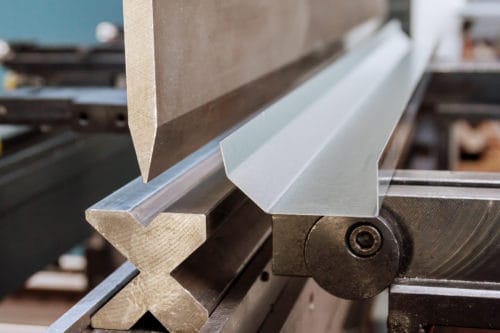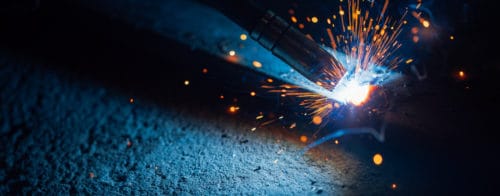Many people refer to welding and metal fabrication as if they’re two different words for the same process. While both processes require working with metal, the terms are not interchangeable. Metal fabrication can be described as the process of creating a product out of metal. Welding is often a part of that process. There are a variety of processes in metal fabrication. Welding is only one of them. Yet welding is a specialized process that requires specific tools and knowledge not used during the other steps of metal fabrication. Learning how each process works can help you better understand the difference between metal fabrication and welding.

Welding and Metal Fabrication: What Are They Exactly?
Welding and metal fabrication are the processes used to shape, cut, bend, and join metal to make different products. Various tools and different methods are used throughout the process to achieve the desired result.
- Welding: A fabrication process where two pieces of metal are fused together by heat, pressure, or both is called welding. Welders use special tools to heat metal and form a bond to join two pieces or repair cracks. Typically, the bond forms completely as the metal cools.
- Fabrication: All processes that are used in building machines or structures from raw metals are considered metal fabrication. Processes may include cutting, burning, welding, machining, forming, and assembly. Sometimes, all processes of fabrication are completed in the same place, but some companies may outsource specific tasks, like welding, to other professionals.
Welding is a fabrication process, so it can technically be referred to as metal fabrication. However, there are many types of metal fabrication that don’t require welding. Therefore, a welder who only uses tools and processes used in welding cannot complete the entire metal fabrication process. Similarly, a metal fabrication shop without a welder cannot complete the welding part of fabrication without the right tools and skill set.
The Metal Fabrication Process
Metal fabrication is the entire manufacturing process used to create metal products or machines. Often, fabrication is completed by a group of specialists who complete different parts of a project. There are many steps in the metal fabrication process, which may include:
Bidding
Capable companies use a description of the product to create a bid for completion of the job. Bids may indicate the ability to complete the entire project in-house or include the cost of subcontracting some tasks to other professionals. One company will have a winning bid and begin the product.
Planning
Before any fabrication begins, the entire project must be carefully planned. Designers and engineers work with the client to understand the product uses and specifications. Then, a plan for the required tools and processes is organized by the team.
Production
The activities used to shape raw materials make up the production process. Production refers to all of the physical processes used to form the final product. These processes include:
- Cutting: Metal cutting is usually completed by machines. Waterjet and laser cutting are the most common technologies used for metal cutting today.
- Casting: Machine dies create molds for specific shapes. The fabricator pours molten metal into these dies to create metal parts.
- Forging: With the use of high-pressure machinery, raw metal is compressed so fabricators can bend and shape it.
- Punching: A punch press is used to punch pre-designed patterns into the metal for decorative or functional purposes.
- Drawing: This process places a specific amount of tension on liquid metal to pull it into a tapered die.
- Milling: A complex machine is used to shave the surface of metal, create angles, perforations, or holes into metal pieces.
- Turning: Metal is placed on a spinning platform to allow technicians to make radial cuts with a tool as the metal spins.
- Extrusion: Used to form cylindrical parts like pipes or wires, extrusion uses a ram to force billets through a die.
The Welding Process
 Welding is the part of the fabrication process used to join metal pieces together. Welders use a variety of specialized tools that comibine heat and pressure to fuse metal pieces together without compromising strength. Welding falls into two main categories:
Welding is the part of the fabrication process used to join metal pieces together. Welders use a variety of specialized tools that comibine heat and pressure to fuse metal pieces together without compromising strength. Welding falls into two main categories:
- Fusion Welding: The act of heating metal parts, then adding a filler to join them together, is called fusion welding.
- Solid-State Welding: A process that heats metal parts and joins them without using additives is referred to as solid-state welding.
Fusion welding and solid-state welding are used for different reasons. These are the four main welding processes used in metal fabrication:
- Shielded Metal Arc Welding (SMAW): A fusion method also known as stick welding, SMAW uses an electric current and welding rods to join metal surfaces.
- Oxy-Acetylene Welding (OA): A tank of oxygen and a tank of acetylene are used with a torch nozzle to create a flame that heats the metal while a filler rod is used for fusion.
- Tungsten Inert Gas Welding (TIG): TIG welding uses a non-consumable tungsten electrode to create the weld.
- Gas Metal Arc Welding (MIG): MIG welding feeds wire with a consumable rod fed through a continuous spool of electrode wire.
Metal fabrication requires a wide variety of processes to create many different products and machines. Welding is an important part of metal fabrication with its own distinct set of tools and processes. Contact the experts at T/J Fabricators to learn more about our metal fabrication processes, or request a quote to start your project today.





10 Comments
Lily Bridgers
In order to level our home’s foundation, my dad is searching for metal shims after seeing some unevenness and settling in certain locations. He wants to guarantee the foundation’s stability and stop any additional harm. He’ll be happy to learn that joining metal components together requires welding as part of the manufacturing process. Metal parts are fused together by welders using a range of specialized instruments that combine heat and pressure without sacrificing strength.
https://www.toltecsteel.com/services
festus Haiduwa
i just want to knw while what is the tools i need to use in welder with they meaning.
Miller Machine Shop
The differences between metal fabrication and welding are explained in detail in this article. Miller Machine Shop For individuals who are fresh to the field, it is beneficial. I would want to see any case studies or real-world examples that highlight the distinctions covered in the text
For More Info:- https://www.fuson-cncmachining.com/
GTA Metal Fabrication
In this enlightening essay on the author’s blog, the difference between welding and metal fabrication is dissected. It provides a lucid description of the differences and similarities that exist between the two processes that are being compared. This content has been thoroughly studied and is appropriate for those who are interested in gaining an understanding of these subjects.
For More Info:- https://www.gfmachineshop.com/
Security Fences
I found this article on welding versus metal fabrication really informative! It’s essential to understand the distinctions between the two processes. Welding seems to be more about joining metals, while metal fabrication is a broader term involving shaping and assembling metal structures. The clear explanations and examples provided here make it easy for anyone to grasp the concepts. dukesmetal.com will be a valuable source for you.
Philip Melchior
Very interested to know about the trade area.
Very inspiring reading through
Need some more information regarding the trade.
my welders
This blog explains the difference between welding and metal fabrication, highlighting that while both involve working with metal, they are distinct processes. Metal fabrication encompasses various steps such as cutting, shaping, and assembling metal into products or structures, while welding is a specialized process within fabrication that fuses metal pieces together.Ornamental Metal Welding blog details the steps involved in both processes and the tools and methods used, emphasizing that welding is just one part of the broader metal fabrication process.
rt ford funeral home
Trekking in Ladakh is one of the best exercise you can do here.
Jaiswal Udyog
You have explained the difference between both very nicely. Please do visit fabricator in Bhilai
Nanda
This is a great breakdown of the key differences between welding and metal fabrication. While welding is a crucial process in joining metal parts, metal fabrication encompasses the entire process, from cutting and shaping to assembly.
To know more: https://convergencesteel.com/rockstar-400-stockist-and-supplier/